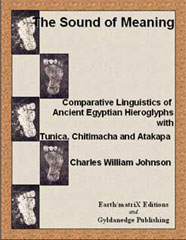
EXCERPT OF
Ancient Egyptian and Purépecha
P’urhépecha | P’orhépecha | Porhépecha | Purhépecha | Phorépecha
By
Charles William Johnson
©Copyrighted November, 2007
Reproduction prohibited.
Purchase in Amazon
Author: Charles William Johnson
ISBN 1-58616-434-1
PDF file 80 page
Copyrighted 2006
172 Pages
Price: $5.99 US
|
Purhépecha = Those who came late, the latecomers Aiu-her-sa = Those who came after, posterity Abstract
The author examines the linguistic correspondence between the ancient Egyptian hieroglyphs and the language generally known as Purépecha of Mexico. The origins of the Purépecha language and people are not known by scholars. Some students attribute the origins to the people of ancient Peru. In this comparative linguistic study, there exist numerous comparisons between the phonemes and morphemes of Purépecha language with the ancient Egyptian hieroglyphs. The extent of the linguistic correspondences causes this author to suggest that some kind of contact existed between the two cultures prior to their known history. The coincidence of correspondences far exceeds the generally accepted idea that all languages are similar to one another within the twenty percentile range. If the linguistic record is reflexive of contact between these two ancient peoples, then the historical record itself must be reconsidered.
Introduction
The Purépecha language of the people once identified as the Tarascan state of the highlands of Mexico is referenced in many different ways: P’urhépecha | P’orhépecha | Porhépecha | Purhépecha | Phorépecha. The meaning assigned to this word-concept is that of “those who arrived late”, inasmuch as the Tarascan people were latecomers to the area in Mexico in which they settled. They were an advanced people in metallurgy and it has even been said that they were the only undefeated people by the Aztecs. Scholars even go on to suggest that they may have overthrown the Aztecs had not the Spaniards done it first during the 16th century.
In my previous linguistic studies where the language of the Aztecs, Nahuatl, was compared to the ancient Egyptian hieroglyphs, it was pointed out that there would also appear to have been some kind of relationship between the two language systems. In Nahuatl, it became obvious that when the letter “L” was eliminated from certain word-concepts, then near cognates appeared with regard to the ancient Egyptian hieroglyphs. In the study of Purépecha, something similar occurs, as will be discussed in detail below. In Purépecha, when one eliminates the initial letter “P” or “J” of certain word-concepts then near cognates appear related to the ancient Egyptian hieroglyphs.
In the comparison of Purépecha with the ancient Egyptian hieroglyphs patterns now arise regarding the omission of the initial letters “J” and “P” which reveal word-concepts from ancient Egyptian. In fact, the pattern is such that the ancient Egyptian word-concepts are relational to many Purépecha word-concepts with or without the initial letters “J” and “P”. In other words, the word-concept in Purépecha could derive from root word-concepts in ancient Egyptian with the initial “J” and/or “P” or without them. Numerous examples of this procedure will be presented below for their analysis.
One is not looking for exact cognitive matches, but suggestive coincidences significant differences should occur within the dynamics of living languages, from changes occurring over centuries, if not millennia. The search is for similarities, but when nearly exact cognates make their appearance surprise abounds.
In revising then the glossaries the reader must remain flexible in perspective. The fact that two word-concepts from two different languages share the same/similar initial consonant and vowel may not be enough to convince ourselves about the possible common origin of these two words. But, in my mind, that alone is significant given the numerous examples that appear, well beyond the generally accepted twenty percentile mark. One then looks for a similarity between the first two (three, etc.) phonemes of a given word-concept comparison. Add to that the possibility that a letter K became over time the letter G, or vice versa, and one begins to understand the nature of the dynamics of language. Even within ancient Egyptian, as will be seen from the glossary, there exists an enormous variation in the same word-concept. In the isolated tables of word-concepts, the order of the glossary is followed: first appears the phoneme and then morpheme or Purépecha; then, there appear the phoneme and morpheme of ancient Kemi in that order:
Purépecha-Phoneme | Purépecha-Morpheme | Kemi-Phoneme | Kemi-Morpheme
Note the expressions within ancient Egyptian in the previous examples: KARSHA, KHAB-T, QERF, QERSH, KHEBEN-T, etc.
The correspondence between the initial phonemes in both languages in my mind is significant. And, one then must consider the initial phonemic comparison within the language of the ancient Kemi-Egyptians. One could attribute such variations to the different scribes who wrote out the hieroglyphs. But, one may also consider the possibility that those differences of graphemes and morphemes had significance for the phonemic expressions of sound. The question then arises, why would one make a distinction between accepting a relationship between Purépecha K’ARH- and Kemi KARF, as being impossible, when one is observing within ancient Kemi itself a similar distinction between Kemi KARSHA and Kemi KARF, or Kemi QERF, etc.
For this study, I have employed various glossaries listed on the Internet for the Purépecha language and Budge’s dictionary of the ancient Egyptian hieroglyph’s cited throughout my linguistic studies. The ancient Egyptian language shall be referred to as that of the Kemi.
|
|
******************
©2007 Copyrighted by Charles William Johnson Earth/matriX,
Science in Ancient Artwork,
Purchase Hardcopies of Earth/matrix Studies
Earth/matrix Editions P.O. Box 231126 New
Orleans, LA 70183-1126
|

